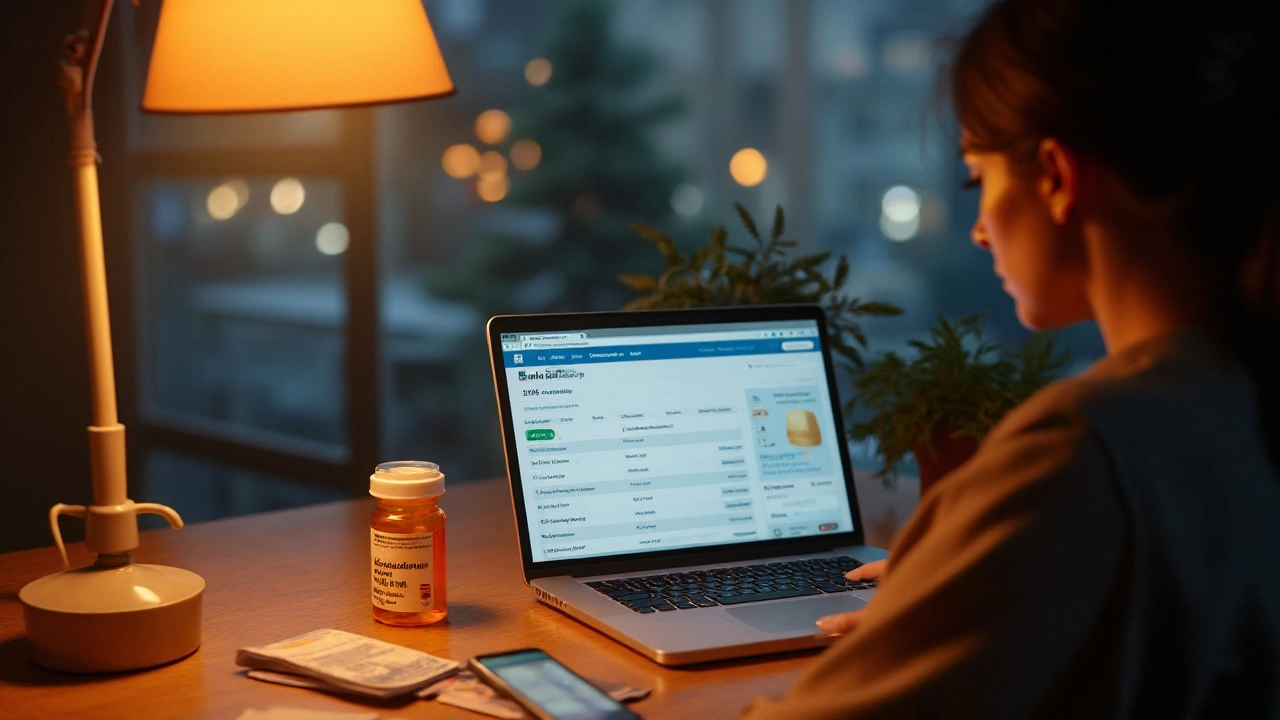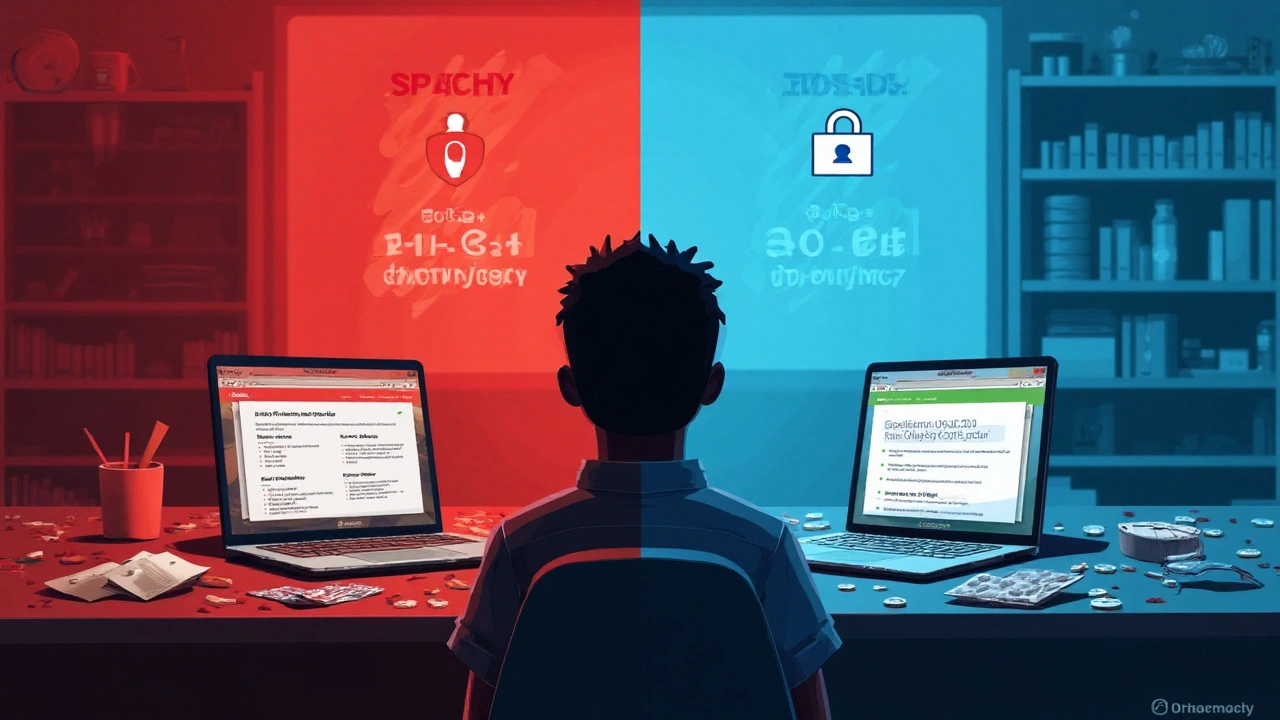
If you typed “buy online cheap generic lamictal,” you’re likely after three things: a fair price, a legit pharmacy, and a hassle-free order that won’t mess with your treatment plan. You can get all three-if you’re picky about where you shop and you stick to the rules. Lamotrigine (the generic for Lamictal) is usually inexpensive, but the internet is full of traps: no-prescription sites, counterfeits, and iffy shipping. I live in Auckland, juggle school runs with my son Lucian and walks with our dog Kepler, so I get the appeal of getting repeats delivered. This guide keeps it real, legal, and safe.
Why buy generic lamotrigine online? Benefits, limits, and what “cheap” really means
Let’s set expectations. Lamotrigine is a prescription-only medicine in most countries, including New Zealand, Australia, the UK, Canada, and the US. That means legit online orders still need a prescription. Any site selling without one is a red flag. The good news: generic lamotrigine is widely available and often very low-cost when you use the right pharmacy or funding route.
Jobs-to-be-done we’ll cover here:
- Find a safe way to buy generic lamictal online without overpaying.
- Know if generic lamotrigine is equivalent to brand Lamictal and when brand might still matter.
- See real-world 2025 price ranges, fees, and how to cut the total cost.
- Check safety basics: prescriptions, side effects, interactions, and legit pharmacy checks.
- Compare options if lamotrigine doesn’t fit, and learn a clean way to place a legal order.
Is the generic equivalent? Yes-regulators like Medsafe (NZ), FDA (US), and MHRA (UK) require bioequivalence for generics. That means the generic has the same active ingredient, strength, and similar absorption to the brand. Some people are sensitive to switches; if your mood or seizure control changed after a brand-to-generic swap, talk to your prescriber. In NZ and the UK, brand continuity can be requested on the script if clinically needed.
What counts as “cheap”? In 2025, cash prices for generic lamotrigine often land in the single to low double digits per month in the US, and are typically low or fully funded in NZ under Pharmac (co-pays vary by policy and eligibility). Avoid paying “brand” prices for generics. Markups can be hidden in shipping fees or small-print dispensing charges.
2025 pricing, discounts, and where to buy safely (with NZ, US, UK pointers)
Here’s what I’d check before entering card details:
- Is the pharmacy licensed where it operates? In NZ, confirm on the Pharmacy Council register. In the US, look for NABP .pharmacy or state board licensure. In Canada, CIPA members are a common check. In the UK, use the MHRA/General Pharmaceutical Council register.
- Do they require a valid prescription? If not, walk away.
- Do they show the manufacturer and lot/expiry on the invoice or pack? Known manufacturers are a good sign.
- What’s the full cost after shipping and fees, and what are the return/refund rules if they ship the wrong strength?
Typical 2025 cash price ranges you can use as a sanity check:
| Region | Strength | Qty (tabs) | Typical cash price range | Notes |
|---|---|---|---|---|
| New Zealand | 25-100 mg | 30-90 | Often low/no co-pay when Pharmac-funded; private cash NZ$6-$25/mo | Prescription required; online NZ pharmacies dispense repeats and ship |
| Australia | 25-100 mg | 28-100 | Within PBS co-pay; private AU$8-$30/mo | Script required; check PBS subsidy status |
| United Kingdom | 25-100 mg | 28-84 | NHS Rx charge per item; private £4-£15/mo | Many patients exempt from NHS charges |
| United States | 25-100 mg | 30-90 | US$4-$20/mo with coupons; higher without | Insurance and discount cards swing prices a lot |
| Canada | 25-100 mg | 30-90 | CA$6-$25/mo | Provincial plans may cover; check deductibles |
Ranges reflect common generic prices seen across community pharmacies and reputable online dispensaries as of mid-2025. Your exact cost depends on dosage, quantity, shipping, funding/insurance, and pharmacy markup.
Ways to lower the bill without playing risky games:
- Use a larger fill if your prescriber is happy-90-day scripts often cut per-tablet cost and shipping frequency.
- Stick to one strength when possible. Mixing multiple strengths to hit a dose can raise dispensing fees.
- Ask for a listed funded or preferred brand. If you felt different after a brand swap, have your prescriber specify brand continuity.
- In the US, load a reputable coupon at checkout. In NZ/UK, pricing is steadier, so focus on funded status and pharmacy fees.
- Check total cost: medicine + dispensing + shipping + card fees. A $0 medicine with $15 shipping isn’t a deal.
NZ-specific: You can get repeats dispensed online by NZ-registered pharmacies using your e-prescription. Importing prescription medicines for personal use generally requires a valid NZ prescription and is usually limited to small quantities (commonly up to 3 months’ supply). Medsafe publishes the personal importation rules-worth a read before considering any overseas site.
Safety checklist: prescriptions, side effects, and red flags you shouldn’t ignore
Lamotrigine has a well-known safety profile, but there are two big reasons not to cut corners: the risk of counterfeit pills and the need for correct titration. Regulators emphasize slow dose increases to reduce the chance of serious skin reactions. Don’t start, stop, or change doses without your prescriber.
Red flags for scam pharmacies:
- No prescription needed, even for prescription-only meds.
- No physical address or pharmacist contact. Vague “worldwide” addresses.
- Prices that are too good to be true, e.g., brand-name prices listed below generic levels.
- Unsecured checkout or odd payment methods only (crypto, gift cards).
- Packaging that arrives unsealed, with foreign-language labels you can’t verify.
Safety basics about lamotrigine (from regulator-approved product information such as Medsafe NZ data sheets and the US FDA label):
- Serious rash risk exists, including Stevens-Johnson syndrome and toxic epidermal necrolysis. It’s uncommon-published figures range roughly from 0.08% to 0.3% in adults-but early recognition matters. Seek urgent care if you develop a rash, mouth sores, fever, or swelling.
- Valproate can markedly raise lamotrigine levels; estrogen-containing contraceptives can lower levels; enzyme inducers (e.g., carbamazepine, phenytoin) can change levels and side effects. Your prescriber will choose a titration plan based on co-meds.
- Pregnancy can change lamotrigine levels; do not self-adjust. Many services monitor levels through pregnancy and postpartum.
- Common side effects include headache, dizziness, nausea, and sleep changes. Sudden mood shifts, agitation, or suicidal thoughts need immediate medical advice.
- If you miss several doses, ask your prescriber before restarting-some people need to re-titrate.
Equivalence notes: Generic lamotrigine matches brand for active ingredient and bioequivalence. In rare cases, excipients differ and some patients notice a change. If seizure control or mood stability shifts after a switch, report it promptly. Some clinicians request “no substitution” if you’re high-risk for destabilization.
Quality signals on the pack when your order arrives:
- Clear pharmacy label with your name, strength, dose instructions, and expiry.
- Manufacturer listed (e.g., Teva, Apotex, Mylan/Viatris, Accord). If the pack is unbranded or looks tampered with, don’t take it-contact the pharmacy.
- Patient information leaflet included in your language.

Alternatives, comparisons, and how to place a legal order step-by-step
Lamotrigine is used for epilepsy and for maintenance treatment of bipolar disorder, especially to help prevent depressive episodes. If lamotrigine isn’t right for you, prescribers may weigh options like lithium, valproate, carbamazepine, or atypical antipsychotics for mood; or other anti-seizure medicines for epilepsy. Each has its own side-effect and monitoring profile. Decisions are individualized-this isn’t DIY territory.
Quick comparison at a glance (non-exhaustive):
| Medicine | Common use | Cost notes | Monitoring/considerations |
|---|---|---|---|
| Lamotrigine | Bipolar maintenance; epilepsy | Generic low-cost in most regions | Slow titration; rash watch; interactions with valproate/estrogens |
| Lithium | Bipolar maintenance | Low-cost generic | Blood levels, kidney/thyroid checks; hydration critical |
| Valproate | Bipolar; epilepsy | Generic; varies by region | Not for pregnancy; liver and platelet monitoring; weight gain |
| Carbamazepine | Epilepsy; trigeminal neuralgia | Generic | Blood counts; drug-drug interactions; HLA testing in some groups |
How to place a legal, safe online order that actually arrives:
- Get your prescription ready. Ask your prescriber to send an e-prescription directly to your chosen licensed pharmacy. If you’ve been stable on a specific manufacturer, ask them to note brand continuity if needed.
- Pick a licensed online pharmacy. In NZ, choose an NZ-registered pharmacy and verify it on the Pharmacy Council register. In the US, use a licensed pharmacy (check the state board) and consider ones recognized by NABP or with a .pharmacy domain. In the UK, confirm GPhC registration. In Canada, look for provincial licensure or CIPA membership.
- Compare the real price. Add the medicine to cart and get to the page that shows medicine price, dispensing fee, shipping, and tax. If that page is murky, try another pharmacy.
- Check manufacturer and strength. Make sure you’re getting the right dose and, if relevant, the manufacturer you tolerate well.
- Place the order and track delivery. Keep the invoice and batch details. Store the tablets in a cool, dry place.
Ethical call to action: stick with licensed pharmacies that require your prescription. It protects you, and it protects the treatment plan your clinician designed for you. If money is tight, ask your prescriber for a 90-day script and a funded/preferred generic; ask the pharmacy for their lowest-cost option; and in countries like the US, apply a reputable coupon. Cutting out the prescriber isn’t a savings; it’s a risk.
Mini‑FAQ
Is lamotrigine the same as Lamictal? Yes for the active ingredient. Generics must meet bioequivalence standards set by regulators (e.g., Medsafe, FDA, MHRA). In rare cases, excipients differ and some people feel a change after switching-talk to your prescriber if that happens.
Can I legally import lamotrigine for personal use? Depends on your country. In NZ, personal importation rules generally require a valid prescription and limit quantities (commonly up to 3 months). Some countries block importation even with a prescription. Check your regulator’s guidance before ordering overseas.
What’s a fair online price? In 2025, generics often cost low single to low double digits per month in many countries. If you see triple-digit prices for generic lamotrigine without a large quantity, question it.
What if I develop a rash? Stop taking it and seek urgent medical advice. Serious rashes can be dangerous. This warning appears in official product information and patient leaflets.
Do I need blood tests? Routine blood tests aren’t standard for lamotrigine like they are for lithium, but monitoring may be used in special situations (e.g., pregnancy, suspected interactions). Follow your clinician’s advice.
Can I split tablets? Some strengths are scored; some aren’t. Many modified-release tablets must not be split. Ask your pharmacist about your exact product.
Next steps and troubleshooting
If the price is still high: Ask your prescriber for a 90-day supply; verify you’re on a funded or preferred generic; try one other licensed online pharmacy and one local pharmacy quote; in the US, load a second reputable coupon and see which tills lower.
If the pharmacy can’t fill your exact manufacturer: Ask if they can source it on the next order cycle or check one other licensed pharmacy. If you’ve had issues with a specific manufacturer, have your prescriber note a preference on the script.
If shipping is delayed: Use tracked shipping when possible. If your supply will run short, ask the local partner branch for an interim supply-they can often dispense against the same e-script.
If you’re switching brand to generic and feel off: Don’t stop abruptly. Call your prescriber. They might adjust the plan or specify a manufacturer for future fills.
If you don’t have a prescription: Book your usual prescriber or an approved telehealth service that can access your records. Avoid any site offering lamotrigine without a consultation and a valid script.
If money is tight right now: In NZ and the UK, ask about funded options and fee waivers or exemptions. In the US, ask your prescriber to e-send to a low-cost pharmacy and apply a known coupon; ask your insurer about mail-order 90-day fills at preferred rates.
One last thought from a dad who orders repeats between after-school pickups: convenience is great, but only when it doesn’t compromise safety. A licensed pharmacy with a clear total price beats a mystery bargain every time.




13 Comments
Always confirm the pharmacy is licensed before you type card details. Check the state board or country register and make sure they require a prescription, then breathe easy and proceed.
Ask for a 90‑day supply if your prescriber agrees, and have them note brand continuity if you’re sensitive to swaps. Save the invoice and batch number when it arrives, and store the tablets in a cool, dry place.
Coupons and discount cards work wonders in the US, and in places with national funding you’ll usually pay much less. Keep your prescriber in the loop about manufacturer changes so dosing or monitoring adjustments happen smoothly.
Regulatory stamps matter. Look for a .pharmacy domain or a state board license, then use industry jargon to reassure yourself: NABP accreditation, e‑prescription verification, third‑party serialization on packing slips.
Don’t fall for opaque checkout flows or crypto‑only payments. That’s rogue supply chain behavior, plain and simple.
Counterfeits are not a distant hypothetical; they are a documented risk and require a methodical approach to detection and reporting.
First, validate the pharmacy’s licensure using official government registries and confirm a physical address and a real pharmacist contact number. Cross‑check that address on a map and make sure the listed phone goes to a business line rather than a generic VOIP provider.
Second, insist on batch and lot numbers on your invoice and on the pack itself. Genuine manufacturers include lot, expiry, and often a manufacturing plant code or country of origin. Record those details as soon as you receive the package.
Third, examine packaging for tamper evidence and printed patient leaflets in your language. Unsealed kits, loose blister packs, or vague foreign language-only inserts are immediate red flags.
Fourth, check pill appearance against a trusted source. Official manufacturer images and imprint codes are available from regulators and pharmacopeias; mismatched imprints or different tablet coloration can indicate counterfeit product.
Fifth, use tracking and documented chain of custody for the shipment. Tracked deliveries with a courier manifest are safer than untracked international drops.
Sixth, if anything seems off, document photos of the pack, keep the pills separate, and contact both the dispensing pharmacy and your prescriber before taking any tablets.
Seventh, report suspected counterfeits to the appropriate regulator immediately. In the US that means the FDA MedWatch program, in the UK MHRA, and in NZ Medsafe. Reporting helps regulators trace supply chains and protect others.
Eighth, be cautious of prescription bypasses and telehealth services that offer instant scripts without review of your history. Legitimate telehealth that integrates with your record and sends e‑scripts to licensed pharmacies is acceptable; pop‑up clinics that push quick scripts are not.
Ninth, preserve all correspondence, invoices, and tracking info for at least six months in case of an adverse event or a formal complaint.
Tenth, be especially careful when importing for personal use; many countries allow limited quantities only and require documentation. Import seizures are real and can leave you without medication at a critical time.
Eleventh, watch for price anomalies. If a listing shows brand‑name prices below generic averages or has inconsistent discounts, it could be laundering of dubious product.
Twelfth, check for manufacturer authorization. Well‑known generic makers like Teva, Apotex, Viatris, and others have established distribution networks; unknown labels on high‑volume offers should be treated skeptically.
Thirteenth, if you are on interacting meds such as valproate or enzyme inducers, ensure your prescriber documents a titration plan and monitors you according to guidelines before any refill changes.
Finally, do not let convenience trump verification. The risk of serious adverse events from an incorrect or fake product vastly outweighs minor savings. Follow the steps above and keep a clear audit trail so that if anything goes wrong you have evidence for rapid action.
Good checklist and very practical :)
When I ordered from a local Canadian online pharmacy I made sure to screenshot every page of the order confirmation and the e‑script transfer. That little habit saved me a headache later when the pharmacy changed the manufacturer on the refill. I politely asked them to annotate the record and they switched it back for me without fuss.
Also keep a small medicine log with dates and any side effects you notice so you can share it with your prescriber at the next visit, even if everything seems fine.
Titration rules are not optional. Start low, go slow, and document every increase. The rash risk is small but real, and the numbers quoted should not be shrugged off.
Also, pregnancy changes lamotrigine levels dramatically and nothing about price or convenience should replace appropriate monitoring in that situation.
Be explicit on the script if brand continuity is clinically necessary; pharmacists will respect a no‑substitution order when it's clearly documented.
Exactly. Reinforce that conversation with your prescriber and ask them to send the e‑script directly to the pharmacy you trust.
Also, mention affordability up front. Many prescribers can suggest a funded or preferred generic or they can reissue a 90‑day script so you avoid frequent shipping fees. Small administrative notes can prevent stress later.
I grab the 90‑day fill when possible and stack coupons when the pharmacy lets me. It cuts down on shipping and those little dispensing fees that add up.
One trick that worked for me: sign up for the pharmacy loyalty program if they have one. Not glamorous but it can drop the price further and sometimes fast‑track customer service when there’s a problem.
Also use tracked shipping. It sounds obvious but the peace of mind is worth whatever small extra cost there is.
If it's sketchy, don't buy it.
Absolutely. No shady vendors, full stop. Bad supply chains harm everyone. 🇬🇧😤
Keep proof, keep receipts, and report dodgy operations without hesitation. The regulators need the data to act, and silence only helps fraudsters.
Prices here are inflated and everyone acts like that's just the way of the world. It isn't. There are always cheaper, smarter routes that don't involve cutting corners on safety.
Clinicians who nod along without demanding pharmacovigilance are part of the problem. Demand proper documentation from prescribers. Demand the manufacturer be recorded. Remain insistent about your health and the traceability of what you ingest.
Also, the whole ‘‘online convenience’’ argument falls apart if you end up in urgent care with a severe rash because someone insisted a pill looked fine. Accountability matters more than a few pounds saved at checkout.
Calm but firm approach is best. Keep records, yes. But also be reasonable with providers - most pharmacists and prescribers want to help and will make changes if asked politely and with the right information.
Documenting reactions and having a clear plan with your clinician helps avoid panic and prevents abrupt stops. Small steps upfront prevent big problems later.
Exactly - communication is the underrated hack here. Be clear about your tolerance, your budget, and what you need from the pharmacy. Most of them will meet you halfway if you bring the facts and stay calm.
Also, rotate pharmacies only when you have to. Consistency reduces the chance of an unnoticed manufacturer swap.
And to close it out, use verified channels for everything. NABP dot pharmacy, GPhC registries, state boards, Medsafe lists - those are the vectors of trust in this ecosystem.
Instant gratification vendors that skip verification are optimizing for churn, not patient safety. Treat every too‑cheap offer like a negative control in a study - it tells you where the experiment will fail.